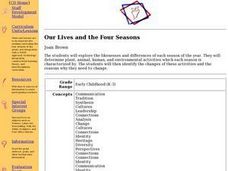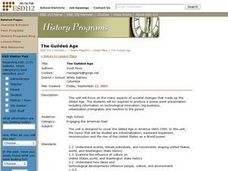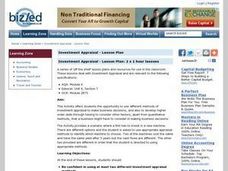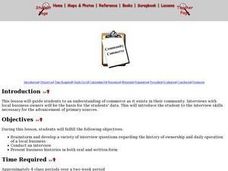Curated OER
Two Very Different Concepts of Time
Students explore the concept of cultural anthropology. In this culture studies instructional activity, students consider the culture of Guinea as they read "The Meaning of Time" by Katherine Ross. Students also discuss the traits of...
Curated OER
Fact and Opinion 3: Post Test
In this fact and opinion worksheet, students answer multiple choice questions about facts and opinions where they identify sentences and identify facts or opinions. Students complete 10 multiple choice questions.
Curated OER
Human Power or Machine Power
Students compare different means for accomplishing tasks. They explain benefits and liabilities for the above different means. Exploration is studied in photos of laborers, animals and machines doing work.
Curated OER
Everything's Coming Up Roses: Creating Beautiful Areas in Your Neighborhood
Learners study the history of Pennsylvania and the city beautification movement that originated in that state. In this community service lesson, students study the city beautification movement started by Mira Lloyd Dock. Learners make...
Curated OER
Our Lives and the Four Seasons
Students compare and contrast the four seasons. Using this information, they determine the plant, animal and environmental activities that can be enjoyed in each season. They discuss why the seasons must change and how humans adapt to them.
Curated OER
America Will Be
Students work together to research and create different types of maps of the United States to be used as part of a geography trivia game.Groups research North American annual rainfall, climate, mountain ranges major rivers and state...
Curated OER
Workers in Factories During the Gilded Age
Seventh graders experience what life was like in the factories during the Gilded Age. They explore the reasons behind the move for work place reforms during the Progressive Era. Students discuss the factors that led to work place reforms.
Curated OER
The Guilded Age
Students examine the Gilded Age in American history. Using the internet, they research the innovations, business, and immigration during this time period. They create a PowerPoint presentation to share their information with the class.
Curated OER
Economic and Social Changes in the High Middle Ages
Students investigate the economic and social changes that occurred in the High Middle Ages. They listen to a lecture and take notes, and in small groups compose a medieval charter and role-play its presentation to the class.
Curated OER
Pile 'em High?
Students explore the concept of architectural heritage. For this architecture lesson, students visit selected websites to compare and contrast the architectural features in world cities.
Curated OER
Landforms - Landform Examples in the Philippines (Matching)
In this landforms worksheet, students match the landforms to their definitions. Students complete 10 matches on this worksheet and answer true and false and multiple choice questions about landforms in the Philippines.
Curated OER
Inside the Vault-Employment Growth in America: What Determines Good Jobs?
Students examine employment growth and the economy. After a teacher lead discussion, students explore types of jobs and their correlation with education level. Job qualifications for both high-paying and low-paying careers are researched.
Curated OER
A Share in America
Learners examine map - reflect on why English colonist kept coming to America (scarcity of land in England / seemingly endless land in America)
Recite line from English poem. They discuss English attitude towards Indians and their lands.
Curated OER
Time, Talent, Treasure, and Economics
Students examine and trace the origin of an item of clothing. They write, illustrate, and publish a book describing the trade flow that brought their item of clothing to the United States.
Curated OER
Investment Appraisal
Pupils use different methods of investment appraisal to make business decisions, and also to develop higher order skills through having to consider other factors, apart from quantitative methods, that a business might have to consider in...
Curated OER
Community Commerce
Sixth graders explore commerce in their own community. They interview local business owners and collect data about their town. Students research the history of a local business and its daily operation. They prepare a presentation to...
Curated OER
Social Studies Word Cards
In this social studies worksheet, students cut apart 50 word cards. All have words which pertain to citizenship and living in a community. There are no definitions provided.
Curated OER
Mexican Independence Day
Students realize that countries have celebrations unique to them and demonstrate their understanding of the concept of tradition. They identify a family tradition that is important to each of them and demonstrate their understanding of...
Council for Economic Education
Econ Ed Link: Economic Spotter: Resources During Wwii
This is a lesson plan that deals with scarcity during WWII. Natural, human, and capital resources are discussed.
Council for Economic Education
Econ Ed Link: The Civil War: A War of Resources
The North won the Civil War in large part due to its superior resources. For this lesson students will learn the difference between capital resources, human capital, and natural resources. They will investigate and compare the resources...
Council for Economic Education
Econ Ed Link: Mystery Workers: Productive Resources
This website focuses on productive resources which are divided into three categories, natural, human, and capital.
Council for Economic Education
Econ Ed Link: Those Golden Jeans
Check out this informative economics lesson plan designed to review the three productive resources--natural resources, human resources, and capital resources--needed to produce goods and services.
Wikimedia
Wikipedia: Capital (Economics)
This site from Wikipedia gives a comprehensive overview of capital. Includes many economic terms with links for further clarification. A good analysis of multiple aspects of capital.
Edutopia
Edutopia: Goods and Services [Pdf]
A unit that teaches the difference between goods and services, the difference between producers and consumers, the difference between human, natural, and capital resources, and the difference between bartering/trading and buying/selling....






















